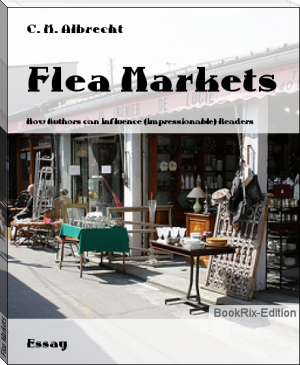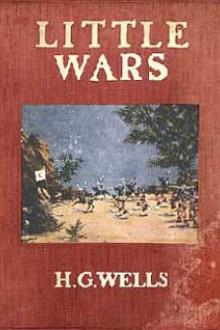Flea Markets by C. M. Albrecht (book club recommendations TXT) 📖

- Author: C. M. Albrecht
Book online «Flea Markets by C. M. Albrecht (book club recommendations TXT) 📖». Author C. M. Albrecht
Many years ago I read “Arc of Triumph” by Erich Maria Remarque. Here is a refugee in Paris after the war. A doctor without license who has to make a living as best he can. I don’t remember much about the book now, except for one isolated incident that really intrigued me. I know the book dealt with many deep issues of war and post-war trauma, and I probably should remember it more for that than for anything, but the part that sticks with me is when the doctor goes looking for a young woman who lives somewhere in the Paris flea market.
Upon reading this a picture immediately formed in my mind, a dismal gray and gigantic shantytown sort of space at the edge of town, an area filled with makeshift dwellings where people sold odds and ends at their doorsteps. A sort of Kasbah without Pépé Le Moko, a place of mystery and intrigue. A place where truands like Pépé could safely hide from the police, a place where adventure awaits and possibilities abound.
Of course I was pretty young at the time, but my mind’s-eye image of that flea market continued to fascinate me throughout the years.
I suppose flea markets have been around forever, but being of an innocent and rather naïve disposition, aside from the market in Mr. Remarque’s novel, I was blissfully unaware of their existence.
Many many years later, while living in San Francisco, I heard in a roundabout way of a flea market in San Jose, less than an hour away on the freeway.
I went and there it was.
Not quite the Kasbah I had imagined all these years, but it had a lot going for it. Stalls and stands stretching out endlessly in all directions, some pretty substantial, others pretty much « pis aller » as they euphemistically say in French. Many vendors had no stands or stalls at all; they just set up folding tables and many others simply displayed their wares on a blanket or a sheet of plastic.
It was all there. If you wandered around long enough, you were sure to find whatever you were looking for, be it a missing part for the transmission of your ’32 Ford or a pair of inexpensive new shoes. There was a lid that would fit the topless teapot you had in the cupboard, a blue willow bowl to round out your collection, a green pepper plant for your garden. How about a Pillsbury Doughboy for your auntie’s collection? You could get your picture taken. You could get your kid’s picture taken — on a pony. When the real pony died, the industrious photographer got a life-size pony made of plastic or something.
Food? Drink? Not to worry. The market organizers made certain you wouldn’t have to shuffle through piles of old clothing on an empty stomach.
We moved away from the area and I learned much to my dismay that most flea markets in other locations tended to be small, hidden inside warehouses or abandoned grocery stores to protect them from the weather (think places like Portland, Oregon). Of course I believe there are large open-air markets around Los Angeles and many other places, but I can’t be everywhere at once. I read once that Walter Lantz, father of Woody Woodpecker, used to maintain a stall at some local flea market around LA and I always wanted to go there and meet him…but alas, although he reached the mature age of 94, I never got there.
Still, the flea that really continued to bite me in those quiet moments just before falling asleep at night, was that rabbit warren in Paris, the way Mr. Remarque described it. I know it rains a lot in Paris too. (Boy, do I!) But in my imagination, I saw make-do canvas awnings casually offering a little protection from the weather, so no problem there.
Finally came The Day. I actually went to Paris. I didn’t go for the sole purpose of visiting the flea market of course, but that was high on the list. Very high. Right up there with the Louvre and Jo Goldenberg’s…oh yeah, and the Eiffel Tower.
Actually, in Paris, as in many large cities, there isn’t just one flea market. Most of them developed around peripheral areas around the edges of the city. I’m still not sure how many are actually in and around Paris, but the neighborhood of Vanves has a neat open air market strung along a few streets where they sell all sorts of interesting stuff. Most of it here tends to have seen better days, but keep your eyes open. Check an item over very closely for artful repairs. You can say the same thing about repairs as you hear about diamonds: they are forever.
In my opinion it’s never good form to belittle an item in the hope of getting a lower price. The vendor knows that if it were as lousy as you pretend, you wouldn’t want it. Be polite, agree that it’s very nice and politely ask the vendor’s bottom price, or perhaps gently suggest a price you think would be good for you. Chances are that you’ll end up with your prize and a friendly handshake to seal the deal.
There’s a much larger market at Montreuil, another peripheral neighborhood. It’s also strung out over an open area and into the street. It’s a warren all right, all in all, close to the picture I imagined, but I don’t think people actually sleep there. (Well, perhaps a few souls «sans domicile fixe» as they say).
The walkways between vendors’ stalls are tight and crowded. The stalls are bursting with stuff most of us would consider junk, but again, you never know what may turn up. Always interesting, and there’s always something to see and do, not to mention that number one Parisian pastime: people watching. Of course the flea markets always have nearby cafés where you can quench your thirst and grab a bite.
The flea market that was mentioned in the book however was my real target. I found it in the village of Saint-Ouen just at the edge of Paris. (Take the Métro № 4, Pte de Clignancourt to the end of the line). Sidewalk vendors lounge along the way almost from the moment you step out of the last Métro station. That is the overture to the opera that is about to unfold. These have no stands, just handfuls of wristwatches, rings, snakeskin billfolds, anything that’s light and easy to carry. I suspect that these are people who have no license or whatever is required to sell out there, so they have to be ready to pack up and move on at a moment’s notice.
Next come the raising of the curtain. You find yourself walking along a crowded street strewn with stalls and tables backed by vans filled with additional inventory until finally, the curtain fully raised, you arrive at the beginning. Actually this is a large conglomeration of different markets, each with its own name and array of venders. Some markets tend to specialize in one thing or another, but I offer that only as a rough guideline. You may find anything anywhere. Many of these shops and stalls are established businesses and you can trust them. Liberty’s for example. Mostly antique clocks.
As you stroll down the crowded narrow and winding cobblestone streets, most of the businesses look like one-car garages with a pull-down metal door. During business hours, the door is raised. The store will be full; the proprietor displays items on the sidewalk in front of the store, and will likely be seen sitting there, wrapped in a big scarf and deeply engrossed in a book. God forbid the vendor should notice you or look like he or she wants or needs your business. But stop and show interest in something and suddenly the proprietor springs to life and is only too happy to discuss the item at great length and almost without fail, you can gently dicker around over the price until you consummate the deal with a smile and a handshake.
A marble top bureau, a grandfather clock, a wonderful four-poster bed…something you can’t stuff into your carry-on? Not to worry. There is at least one shipper right in the heart of the market who will take care to pack and have your purchase delivered to you back home.
Merchandise here ranges from pure junk to museum quality pieces. Got 5,000 euros for a little mirror? You can get that into your carry-on. If you’re serious about the really good stuff, bring a high-limit credit card or beaucoup euros.
I can’t say, but I suspect that many of these vendors have tiny living quarters at the rear and/or above on little mezzanines at the back of the shop. All around the area too are actual homes, apartments, hotels and bed and breakfast establishments. Cafés abound, many of them quite colorful, like the one with girdles, bras and neckties, etc hanging from the ceiling.
The most well-known, indeed famous café of course, is Chez Louisette. Singing, music, family-style dining atmosphere of light-hearted camaraderie. It is said that many famous entertainers got their start Chez Louisette. The beer and wine flow and people love the place, locals and tourists alike. Right in the heart of the market area. It’s inside off the street, but just mention “Louisette” to anyone and you’ll be pointed in the right direction.
***
Presently I live in Sacramento, California. We have a couple or three flea markets, but the biggie is Denio’s in Roseville, on the periphery of Sacramento. It’s been there over sixty years now. A great place to stroll about when the weather is nice, which is most of the time. You can walk off those extra pounds and people watch too. You wander up and down row upon row of stalls, some inside and others outside. You may not find any museum-quality pieces you can’t afford anyway, but if it’s made or grown, somebody probably has it for sale there. They have a huge farmer’s market as well, and many locals really load up on all sorts of fresh fruits and vegetables, etc.
Food and drink are readily available at every turn. Our personal favorite is Moreno’s, a tiny taco stand that has been there just about since the late '40s. Celia (those who are Spanish challenged call her Sally) and her sister Rachel who run it now, grew up on the spot making tacos at the knees of their grandparents who started the business in the late 40s. They still follow their abuelita’s original recipes for tacos, enchiladas, rice and beans. I believe they started with tamales, but eventually came around to specialize in those All-American delicacies, Tacos and Enchiladas. Tamales are a bit on the heavy side.
At home we sometimes discuss whether the family slips something illegal into the food, because this stuff is like a controlled substance; almost every week you have to go out to Moreno's and get a fix.
With the unending demand for expanded construction, I have a dreadful feeling that Denio’s vast vending area and its even vaster parking area, is quickly becoming more valuable as a development than it is





Comments (0)